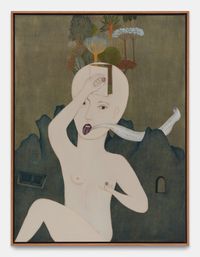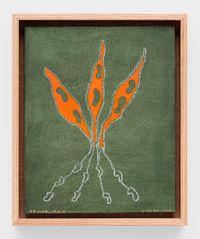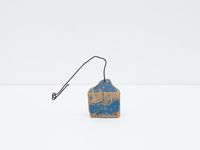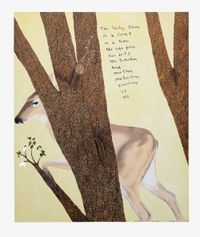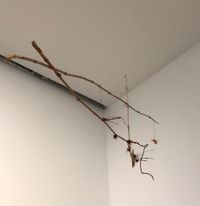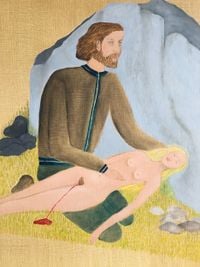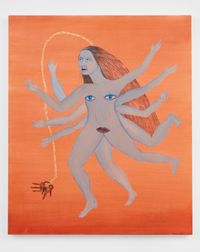Characterised by ritual and collective action, Cecilia Vicuña's practice encompasses sculpture, poetry, site-specific installation, film, sound art, and performance. Closely intertwined with activism, Vicuña's artistic output since the 1960s has addressed climate change, ecological destruction, women's rights, colonialism, and cultural memory.
Read MoreBorn into a family of artists and writers, Cecilia Vicuña began writing and drawing intensely at a young age. In 1964, her father built her a studio in the garden, where she made abstract paintings during her teenage years. However, her true artistic awakening occurred in 1966 at the age of 17; while standing on a beach, Vicuña was suddenly struck with a sense of the connectedness of the universe. As The New York Times reports, Vicuña 'picked up a stick, turned it vertically and stuck it in the sand', and knew her art practice had begun.
This type of impermanent sculpture provided the basis for her most renowned body of work. Entitled 'Lo Precario' ('The Precarious'), the series is a loose grouping of ephemeral and participatory works intended to bridge the gap between art and life. In 1966, Cecilia Vicuña created her first precarious objects, 'Basuritas' ('Little Rubbish'), comprising assemblages of natural and man-made debris, sometimes bound by string. Vicuña would often create these works in situ, leaving them vulnerable to change by natural elements such as weather and rising tides. As Cecilia Vicuña's website describes, the works 'reflect ancient spiritual technologies—a knowledge of the power of individual and communal intention to heal us and the earth.'
Politics and collective action form a central part of Cecilia Vicuña's life and work. In the same year as her artistic epiphany, Vicuña enrolled in the Architecture School at the University of Chile before transferring to the university's Fine Arts School. Shortly after being offered a scholarship to study at London's Slade School of Fine Arts, University College, Chile's elected president Salvador Allende was deposed by a military coup. Exiled in London, Vicuña co-founded a pro-democracy artists' organisation and organised the Arts Festival for Democracy in Chile at the Royal College of Art in 1974.
One series of paintings begun in the 1970s conveys her anti-colonial values by featuring Latin American revolutionary heroes in an attempt to counter 'the art of the conquerors and the "saints" inherited from the Catholic Church.' In the eponymous 1978 oil painting Camilo Torres, the Colombian socialist and priest is depicted partially in Catholic robes and partially in his military uniform, surrounded by peaceful figures, flowers, and a white bird.
Another of Cecilia Vicuña's major series of works is inspired by quipus: pre-Columbian record-keeping devices made of knotted cord or rope, which were banned by Spanish colonisers in 1583. These works often respond to local geography; presented in her 2021 solo exhibition at Lehmann Maupin, Seoul (18 February–24 April), the installation Quipu Girok (Knot Record) features vertical fabric hangings that pay homage to quipu and Korean textile traditions.
In addition to her visual art practice, Vicuña is an accomplished poet. She published her first poem in 1967, and in the same year founded the art and poetry collective Tribu No in Santiago. Since then, she has published over 20 volumes of poetry. In 2005, Vicuña was appointed Phipps Chair in Contemporary Poetry at the University of Denver. In 2009, she co-edited The Oxford Book of Latin American Poetry and co-founded Oysi, a non-profit organisation and website dedicated to the preservation of oral traditions around the world.
Cecilia Vicuña's dedication to poetry is also evident in her film, What is Poetry to You? (1980), where the artist takes to the streets of Bogotá, Colombia, to ask passers-by the titular question. Poetry and quipu also form the basis for her performance, where quipu serves as a prompt for collective storytelling.
Cecilia Vicuña's artwork is held in numerous public and private collections around the globe, including the Blanton Museum of Art at The University of Texas at Austin; Fonds Régional d'Art Contemporain de Lorraine, Metz; Museo de Arte Contemporáneo, Santiago; Museo Nacional de Bellas Artes, Santiago; Solomon R. Guggenheim Museum, New York; Tate Gallery, London; and the Berkeley Art Museum and Pacific Film Archive, Berkeley.
Cecilia Vicuña solo exhibitions include Cecilia Vicuña: Seehearing the Enlightened Failure, Museo Universitario de Arte Contemporáneo (MUAC), Mexico City (2020); Cecilia Vicuña, a retrospective exhibition, Witte de With Center for Contemporary Art, Rotterdam (2019); Cecilia Vicuña: About to Happen, Berkeley Art Museum and Pacific Film Archive, Berkeley (2018); Cecilia Vicuña: Disappeared Quipu, Brooklyn Museum, New York (2018); and Quipu Austral, FRAC Lorraine, Metz (2013).
Cecilia Vicuña group exhibitions include Artistic License: Six Takes on the Guggenheim Collection, Solomon R. Guggenheim Museum, New York (2019); Radical Women: Latin American Art 1960-1985, Hammer Museum, Los Angeles (2017); Dance/Draw, the Institute of Contemporary Art, Boston (2011); On Line: Drawing Through the Twentieth Century, Museum of Modern Art (MoMA), New York (2010); WACK! Art and the Feminist Revolution, the Museum of Contemporary Art (MOCA), Los Angeles (2007); and Inside the Visible, Institute of Contemporary Art, Boston, which also travelled to the National Museum of Women in the Arts, Washington, DC, the Whitechapel Art Gallery, London, and the Art Gallery of Western Australia, Perth (1996).
Her work has also been presented at documenta 14 (2017); the 18th Sydney Biennale (2012); and the Whitney Biennial (1997).
Elliat Albrecht | Ocula | 2021
